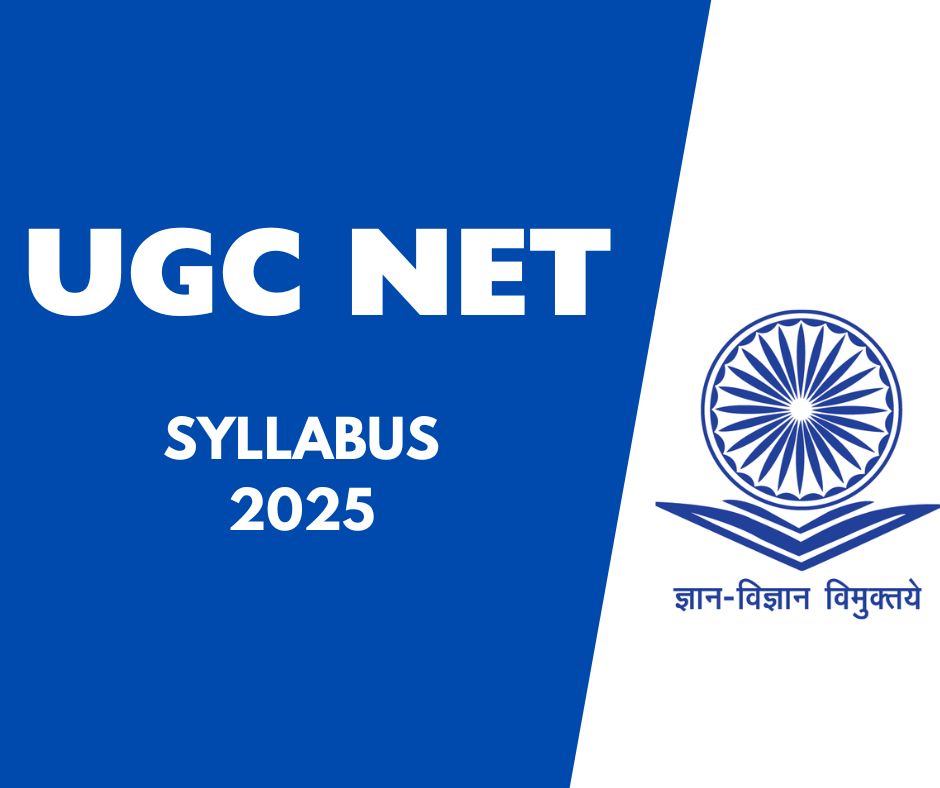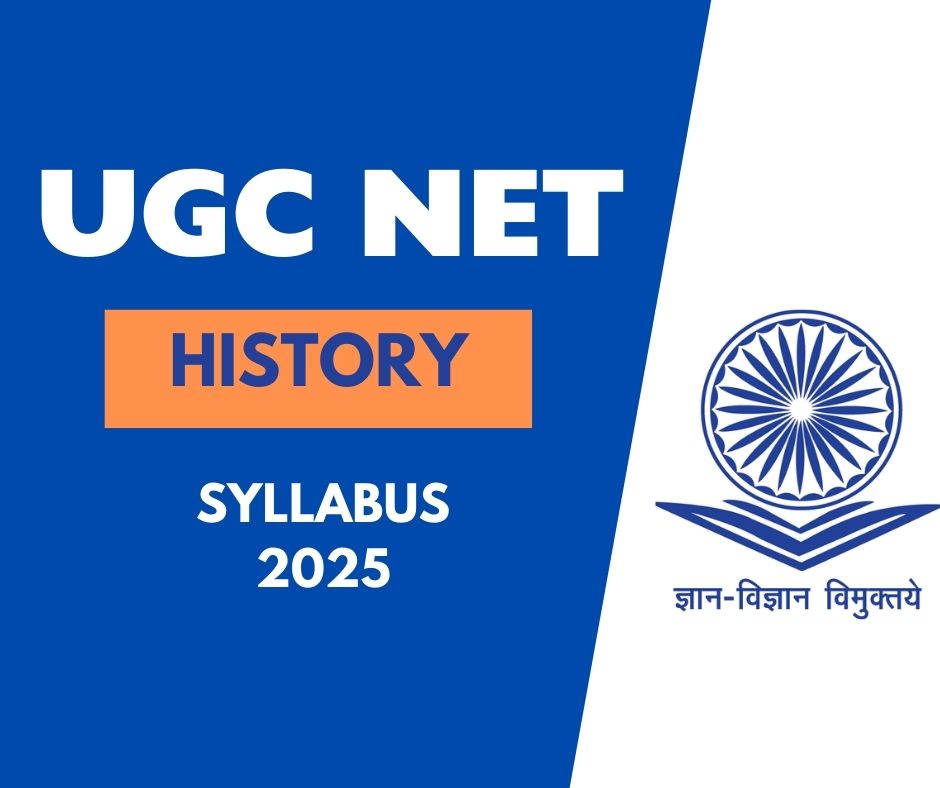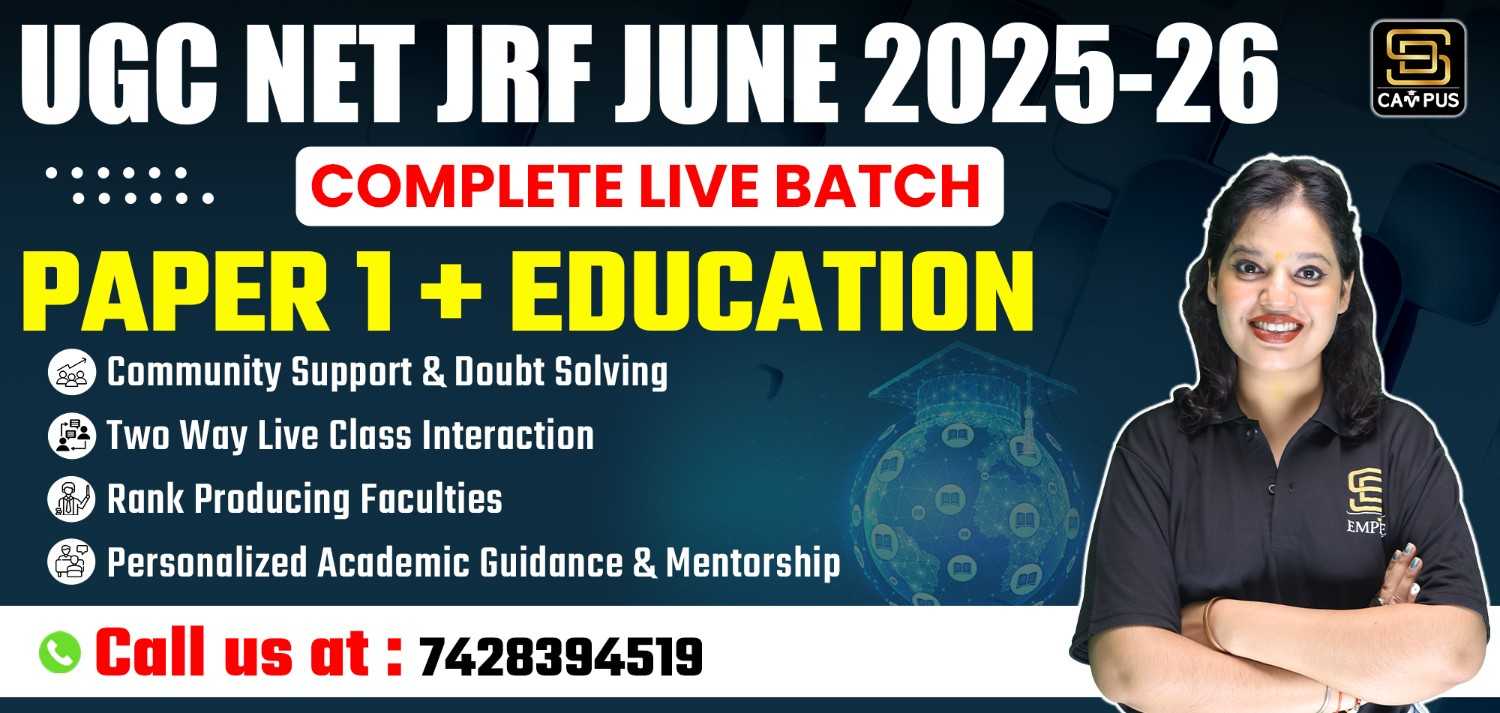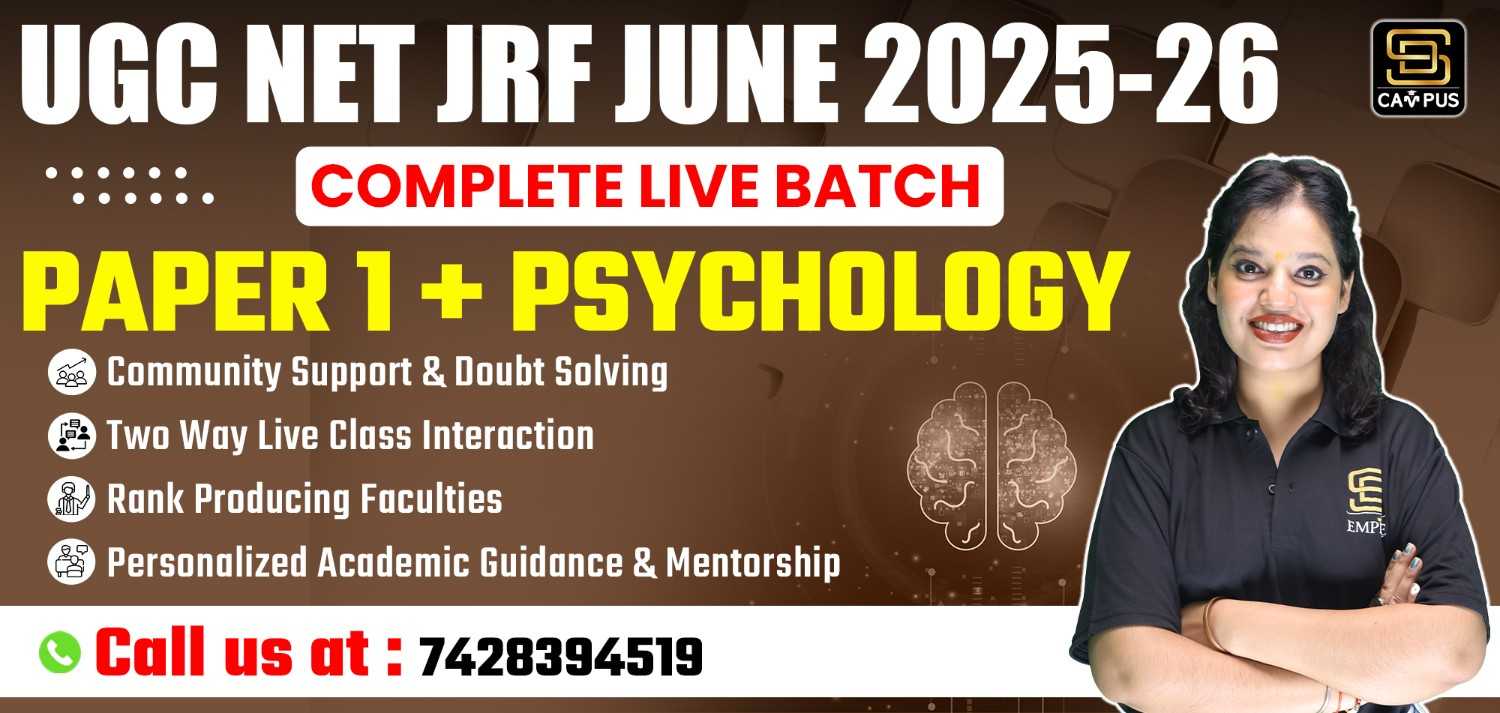UGC NET Syllabus Population Studies includes the topics for paper 1 and paper 2. Candidates need to go through the syllabus and prepare for the exam accordingly. NET exams are conducted to qualify candidates for the assistant professor, JRF, and PhD.
Continue reading the article till the end to discover the UGC NET syllabus population studies, exam pattern, and preparation techniques to succeed.
Table of Contents
ToggleUGC NET Syllabus Population Studies Overview
The table below consists of essential information on the UGC NET population studies:
| Exam Name | UGC NET Population Studies |
| Exam Conducting Body | National Testing Agency |
| Post |
|
| Exam frequency | Twice (June and December) |
| Exam Level | National Level |
| Mode of Exam | Online |
| Medium of Exam | English and Hindi |
| Time Duration | 3 Hours |
| Number of papers | Paper 1: General
Paper 2: Political Science |
| Total Marks | Paper 1: 100 marks
Paper 2: 200 marks |
| Official Website | ugcnet.nta.nic.in |
UGC NET Population Studies Paper 1 Syllabus
UGC NET Population Studies Syllabus Paper 1 PDF includes the following topics:
- Mathematics and reasoning
- Teaching Aptitude
- Research Aptitude
- Comprehension
- Communication
- Logical reasoning
- Data Interpretation
- Information and Communication Technology (ICT)
- People, Development and Environment
- Higher Education System
UGC NET Population Studies Paper 2 Syllabus
The UGC NET syllabus population studies paper 2 is vast and has 10 units as mentioned in the table here:
| Unit | Topics | Details |
| 1 | Introduction and Sources of Population Data | Population Studies:
|
| 2 | Methods of Demography/Population Analysis | Rates, Ratio, Proportion, percentages, density, incidence and prevalence, person-years Rate of Population Growth: Arithmetic, Geometric and Exponential growth rates, Decadal growth rate Doubling time, concept of population stabilization and net reproduction rate unity Crude and Standardized methods for fertility and mortality estimates. Location of the event in time and the Lexis diagram. Method of Population Projection: Mathematical methods of population projection (Linear, Exponential, Polymonial, Gompertz and Logistic Growth Curves for Population Projection); Component method of Population projection; Sub-national population projection; Projection methods of labour force, school enrolment, workforce and households etc. Population Projections by United Nations, World Bank and Expert Committee of Government of India, Population estimates: Inter censual/Post-censual estimates of population, population pyramid. Population and sample parameters, sampling distribution of mean and standard error. Statistical Methods: Frequency distribution, descriptive and inductive statistics, measures of central tendency (mean, median, mode); measures of dispersion (range, variance, and standard deviation); correlation and linear regression, introduction to testing of statistical hypothesis and test of significance, interpolation, and extrapolation. |
| 3 | Population Composition and Change | Spatial and temporal changes in the size and distribution of population-global perspective with focus on India Age and sex structure of population in developed and developing countries Composition of India’s population: Demographic, social, economic and Cultural factors affecting age-sex structure of population and its relevance in population dynamics: global and India perspectives; Spatial distribution of population: measures of concentration of population: density, distribution-dissimilarity index, tempo of urbanization, Rank-size rule, Gini’s concentration ratio, Lorenz curve, etc. ; Factors affecting spatial distribution, density and concentration of population-global, national, regional patterns. Population Ageing: Concepts and measures of population ageing, components of population ageing. Trends and pattern of ageing in India and States. Demographic dividend, Sex-ratio, Sex-ratio at birth, Child-Women ratio, Median Age, AgeSex Pyramid, Dependency Ratio (Child Dependency Ratio, Old Dependence Ratio, Total Dependency Ratio).
Social, economic and health aspects of Ageings; Living arrangements, family support, dependency; Emerging issues related to elderly. |
| 4 | Nuptiality and Fertility | Nuptiality: Concepts and sources of data; Measures- crude marriage rate, age-specific marriage rates, order specific marriage rates, singulate mean age at marriage (SMAM); – a. Singulate Mean Age at Marriage (SMAM) – Synthetic Cohort and Decadal Synthetic Cohort Method. b. Indices of Nuptiality (Coale’s Indices) Marriage patterns in India: levels, trends and differentials in age at marriage, divorce, widowhood, widow remarriage Levels and trends in widowhood in India and States, Impact of changes in widowhood/ divorce on fertility, mean age of widowhood/divorce from Census data. Fertility: Basic concepts and terms used in study of fertility. Fertility Indicators: sources of data and their computation, Cross-sectional or Period indicators: Crude Birth Rate (CBR), General Fertility Rate (GFR), Age Specific Fertility Rate (ASFR), Age Specific Marital Fertility Rate (ASMFR), Total Marital Fertility Rate (TMFR), Total Fertility Rate (TFR),Gross Reproduction Rate (GRR), Net Reproduction Rate (NRR), Replacement level Fertility, Birth order statistics, Child Women ratio, Order Specific Fertility Measures. Cohort Indicators: Children ever born, completed family size. Age Standardization or Adjustment, Direct and Indirect Standardized Birth Rates, Sex-Age Adjusted Birth Rate.
Levels, Trends and Differentials of Fertility in India, Determinants of Fertility: Post-Partum Amenorrhoea (PPA), Breast feeding, Sterility, Fecundity and other factors. Framework of fertility analysis: Davis and Blake Intermediate Variable Framework, Bongaart’s Proximate Determinants, Lee and Bulatoo Framework of Fertility. Indirect Methods of Estimation of Fertility : Coale-Trussell’s Model for Age Pattern of Fertility, Reverse Survival Technique of Fertility Estimation, Rele Technique, P/F Ratio Technique, Brass P1/F1Ratio Technique. Fertility transition in developed and developing countries with special reference to India, Implications of below replacement level of fertility |
| 5 | Mortality, Morbidity and Health | Mortality: Basic concept, definitions and measures of pregnancy wastage (miscarriage, abortion, fetal death, still birth), live birth; early, late and post neo-natal deaths; infant and child death. Mortality Indicators: Crude Death Rate (CDR), Age Specific Death Rate (ASDR), Infant Mortality Rate (IMR), Under-five mortality Rate, Neo-natal mortality rate, Post-natal mortality rate; Maternal Mortality Rate (MMR). Infant Mortality: Levels and determinants of Infant and Child mortality in India, causes of Infant mortality (Endogenous and Exogenous). Mosley and Chen’s Framework for Child Survival Sources of Mortality Data and its Quality: Measures of mortality, need and importance of the study of mortality for policy and public interventions; relative merits and demerits of mortality measures. Levels and Trends in mortality by developed and developing regions with special reference to India, age and sex specific mortality, differentials in mortality by place of residence and socio-economic characteristics, factors responsible for high mortality in the past and reasons for mortality decline in developing countries. Indirect method of estimation of Infant and Child mortality rates Direct and Indirect standardization of mortality rates, Life Table: Basic concepts, types and forms of life tables and Model Life Table, need of Model Life Table (MLT), UN Model Life Table, computation of life table, construction of life table based on age-specific deaths rates (ASDR), underlying assumptions of life table construction using ASDRs of community during specified period, use of life table application of life table in demographic analysis.
Morbidity: Concepts and definitions of health and morbidity; sources of data and measures of morbidity. Morbidity Indicators: Incidence, Prevalence and Case-fatality ratio. Overview of epidemiological transition in developed and developing countries with special reference to India Health: Reproductive Health:- Definition, rationale, approach, evolution of ideas about reproductive health; Maternal morbidity, Emergency obstetric care, Adolescent reproductive morbidity, Strategies to reduce maternal morbidity and mortality in India, Abortion related issues. Reproductive Tract Infection (RTI)/Sexually Transmitted Infection (STI), HIV/AIDS and their implications. Reproductive Rights and Ethical Issues Causes of Deaths Statistics: Definition and sources of causes of death statistics, Introduction to International Classification of Diseases (ICD – X (1990), Global leading causes of death with special reference to Asia and India; Distribution of deaths by main causes and by age, life expectancy. Burden of Disease Estimates: Need for the study of burden of disease; Basic concepts; Measures of Burden of Disease; and current scenario of burden of disease in India by States/UTs. Ageing and Burden of Diseases, Life expectancy and disability free life expectancy |
| 6 | Urbanization and Migration | Urbanization: Concept and definition of ‘Urban’ in India and other countries. Process of urbanization, measures and sources of data. Inter-relationship between urbanization and migration in developed and developing countries. Trends, patterns, characteristics and differentials of Urbanization in India. Classification of settlements, characteristic, evolution and growth, morphology, land use patterns and functions, spatial organisations, principles of centrality and hierarchy, methods of measuring centrality, central place region, contribution of Christaller and Losch. Urbanisation and Urban Change – changing distribution of world’s urban population, principles and causes of urban growth, urban hierarchy (rank size rule), characteristics of primate city, cycle of urbanization, economic and social theories of formation of urban centres, stages of urban development models, demographic and social change in post World War-II urban system in developed and developing countries. Socioeconomic and environmental consequences of urbanization and urban growth in developed and developing countries:– employment, urban informal sector, basic amenities, housing, health, education, elderly population, environment, sustainability, smart cities and urban future. World Cities:– hierarchy of world cities, growth and activities of the institutions of global capital.
Migration: Basic concepts and definitions – circulation, mobility, commutation and migration. Sources of data – nature, coverage and limitations of the available data. Types of migration: internal and international Trends, Patterns and differentials of Internal and international migration. Determinants and consequences of Internal and International migrations. Refugees – issues and implications. Direct and indirect measures of migration – estimation of lifetime and inter-censal migration rates from census data, indirect measures of net internal migration using Vital Statistics Method, National Growth Rate Method, Census and Life Table Survival Ratio methods, Methods of estimating international migration Theories of Internal and International Migration – Ravenstein, Everett Lee, Lewis-Fei-Ranis model, Todaro, Stouffer, Zelinsky, Neoclassical Economic Theory, New Household Economic Theory, Duel Labour Market Theory, World System Theory, Social Network Theory, Cumulative Causation Theory. |
| 7 | Population, Development, and Environment | Environment in the context of development, interrelationship between population growth, environment and development Concepts of Development and its Measures: Limitations of per capita income as an indicator of development, human centered development-welfare approach, investment in humancapital approach, Human Development Index (HDI), Physical Quality of Life Index (PQLI), Concepts of Social Development, Social capital and Social change; Social Development Index (SDI), Gender Development Index (GDI), Millennium Development Goals (MDG), Concept of Sustainable Development, Sustainable Development Goals (SDG),Concepts and Measures of Poverty, Human Poverty Index (HPI). Effect of development on population dynamics, age structure transition, demographic transition, demographic dividends and population ageing. Views regarding the relationship between population and development: (i) Views of different religions on pro-natalist and prosperity argument: Greek philosophers’ views, Chinese philosopher Confucius writings on optimum population, Classical Mercantilist and Physiocrats views, Socialist and Marxist views etc. (ii) Pessimistic perspective: Population growth viewed as an obstacle to development, Malthus theory, Coale and Hoover study, Tragedy of commons, Limits to growth study and Enke’s investment model etc. (iii) Optimistic perspective: Population growth is conducive to development – Mercantilist views, Colin and Condorcet views, views of Colin Clark, Ester Boserup and Julian Simon etc. (iv) Neutralist/revisionist perspective: Need to study linkages between population change and development- views of Simon Kuznets, Allan Kelly and Robert Schmidt, Bloom and Williamson etc. Population and Resources: Natural resources: types of natural resources, renewable and non-renewable resources, resources scarcity and resource depletion.
Capital resources: effect of demographic factors on savings and investments, technology and development; importance of technology to improve the productivity of physical assets. Human resources: quantitative aspects:- concepts of labour force, economically active population, unemployment, types of unemployment; disguised, seasonal, frictional and chronic. Factors affecting demand and supply of labour, effect of population growth and development on structure of employment. Implications of population growth: on food supply, water, sanitation, housing, employment, health, education , energy, etc; environmental degradation – air pollution, greenhouse effect – global warming, climate change; pressure of population growth on land use:- soil erosion, desertification, deforestation, and soil salinity etc. Human Eco-systems:- ecological imbalance caused by natural and human factors and their impacts on human ecological systems, human perception and adjustment to imbalance, sustainable human eco-systems. Guidelines for environmental protection, international protocols Developmental plans, polices and strategies in India in the context of Population and environment. |
| 8 | Population Issues: Gender and Special Groups Gender | Concept and meaning of gender; evolution of gender in historical perspective, Gender and its relationship with components of population: Age-sex structure, Fertility, Mortality, Migration. Major morbidity and mortality burden in the developing world with major focus on India, Sex ratio at births, major health problems experienced by women and men, reproductive health of women and men in developing world, differentials in use of male and female methods of contraception Health and Nutrition issues of adolescent boys and girls , abuse and maltreatment, puberty, sexual debut, adolescent pregnancy, abortion, women and family planning programs, contraceptive technology, Major risk factors of men’s health: masculinity, alcoholism, tobacco and drug consumption, accident etc. Gender dimension of economic development: women’s access to economic resources, entitlements, land ownership, inheritance laws, access to credit, measurements of women’s work, profiling women’s work, informal sector involvement, working condition, maternity benefits, wage differentials, gender and poverty Globalization: changing pattern of economic activity, issues of marginalization and vulnerability along with agency, negotiation and spaces of power, gender divisions in urban labor markets, gender and migration
Housing, household environment and its differential impact on men and women’s life, Environmental degradation: changes in climate, water table and land use and their differential impact on men and women The Concept of gender mainstreaming: gender mainstreaming in various health and development sectors- e.g. Agriculture, Health, Education, gender in work place (public & private) etc. Gender inequality and status of women:- social, economic, cultural, health and domestic violence, women autonomy and empowerment and its demographic implications, gender empowerment measure (GEM). Scheduled Castes (SC) and Scheduled Tribes (ST): size, growth, composition and distribution in India, development plans and programmes for SC and ST and their impact on population. Disabled / Physically challenged population: size, growth and distribution in India, classification of physically challenged population. Development Plans and Programmes for physically challenged population in India. |
| 9 | Population & Health Policies and Programmes | National Policies: Evolution and Development of Population, Health and related Policies viz., National Population Policy 1977, National Health Policy 1983, National Population Policy 2000, National Health Policy 2002, National Health policy 2017, National Nutrition Policy, National Policy on Older Persons, Social Security for Elderly, Legislations to protect Elderly in India, Protect National Youth Policy, National Policy on HIV/AIDS, National Environment Policy etc., its Purpose, Goals & Objectives, Thematic areas and Strategies. Population and Policies on special groups, Ageing and Disabilities, Ageing and Quality of Life, Ageing and Mental Health problems, Social Gradients of health for Ageing Population, Healthy Ageing, WHO Frame Work for Healthy Ageing. Geriatric care in India Role of NITI Ayog in Health and Population related policies and programme Population, Health and related Policies and Programme at State levels. Evolution of Family Welfare Programme in India since 1952, Population control strategies under different Five Year Plans till current period.
Recommendations of various Experts Committee viz., Bhore Committee, Mudaliar Committee, Chadha Committee, Mukherjee Committee, Jungalwalla Committee, Kartar Singh Committee, Shrivastav Committee, Bajaj Committee etc. National Heath Mission (NHM): History and Evolution, various schemes under NHM: Reproductive, Maternal, Newborn, Child Health and Adolescent (RMNCHA) Programme etc. Policies, Programmes and Legislations in India: related to Age at Marriage, Medical Termination of Pregnancy, Sex Selected Abortion (PCPNDT Act), COTPA Act-2003 (Tobacco Control Act), Policies and Programme related to Reproductive and Child Health. Adolescent Health, Child Health, Ante Natal, Natal and Post Natal Care, Immunization, Vitamin Deficiency, Diarrhoea and Acute Respiratory Infection, Family Planning, RTIs/STDs; HIV/AIDS, Public Health Nutrition; Causes of Infertility and its Treatment in government programme, Social and Psychological consequences of Infertility, Socio-Psychological and Health problems of menopausal women. Family Planning Methods-Traditional vs Modern Methods, Advantages/Disadvantages, Effectiveness of various methods, Achievements of various components of RMNCH+A Programme National Programme for Health care of Elderly, Communicable and Non Communicable Diseases, programme. Methods and approaches of impact assessment of different policies and programme on Population and Health of people. Health Infrastructure and Delivery System in India: Health System functioning in India, Organizational Structure- Sub Heath Center, Primary Health Center, Community Health Center, Health System of District ,State and Center levels, Role and Responsibilities of various categories of health personnel in Family Welfare Programme, Concept and Implementation of Universal Health Care in India. Decentralization Strategies in Health, Role of Panchayati Raj Institutions (PRIs) in Health, Health Systems Reforms in India, Public-Private Partnership in Health and Family Welfare services, Role of ICDS in reducing malnutrition and coordination with health sectors, Intersectoral Coordination for improving hygiene, water and Sanitation etc . Basic Concepts in Public Financing in Health: equity, efficiency and effectiveness of health care delivery, basic concept of investment in health, public goods and private goods, externalities, public sector spending on health, Basic Concepts in National Health Accounting, Need & Concepts in Social Health Insurance, Schemes in Social Health Schemes, principles and methods of economic evaluation of population & health programmes. Global Issues and Challenges in Population and Health: Concept of global health, global demographic, health and epidemiological Transition, Role of United Nations and Other International Agencies like UNFPA, Population Council,WHO etc in Health and Population; UN World Population Conferences: Bucharest (1974), Mexico (1984), Cairo (1994) Conferences, Alma Ata Declaration (1978)-Health for all by 2000, Components of Primary Health Care, Millennium Development Goals (2000), Sustainable Development Goals (2016). Health Policies and Health System in developed and developing countries. |
| 10 | Research Methodology and Programme Evaluation | Principle and methods of Social Science Research, Scientific Research-conceptual, empirical, and analytical framework of research, Types of Research: action research, operations research, formative research, programme evaluation research Research Design: Observational Study (Descriptive and Exploratory Study) and Experimental Studies (Quasi-Experimental and True Experimental Study, Longitudinal and Panel Study Design, Issues relates to reliability and validity in research design. Method of Data Collection and Analysis: Quantitative and Qualitative methods of data collection, and quality of data in evaluation research. concept and application of odds ratio and relative risks, concept and application of probability in analysis of population data, laws of probability and concept of Baye’s Theorem, Concept and application of Binomial, Exponential, and Normal Distributions in population data analysis. Concept of a statistical hypothesis, concept and application of correlation, association and regression, the concept of p value (level of significance), concept of confidence interval, concept and application of logistics regression analysis. Sampling: Sampling concept, concept of sampling unit, sampling frame and sampling design, sampling and non-sampling errors, standard error, sample size determination Sampling Methods and Techniques: Simple random sampling, stratified random sampling, systematic random sampling, cluster sampling, purposive sampling, multi-stage sampling, Design effect in sampling. Research Problem and Formulation of Research Hypotheses: defining the research problem; and components of the research problem; Formulating the research hypothesis.
Concepts and Applications of GIS in Population Studies |
UGC NET Population Studies Study Material PDF
The UGC NET Population Studies syllabus includes topics for paper 1 and paper 2. As the exams are conducted in bilingual mode, candidates can get the syllabus in Hindi or English as well. Check the table below for both paper syllabus links:
| UGC NET Population Studies Study Material PDF | |
| Population Studies Paper 1 Syllabus | UGC NET Paper Population Studies Paper 1 Syllabus |
| Population Studies Paper 2 Syllabus Hindi | UGC NET Paper Population Studies Paper 2 Syllabus Hindi |
| Population Studies Paper 2 Syllabus English | UGC NET Population studies syllabus PDF English |
Marking Scheme and Exam Pattern
UGC NET population studies don’t have a negative marking scheme. Refer to the table below for the exam pattern for the NET exam:
| Papers | No of Questions | Total Marks | Duration |
| Paper 1 | 50 | 100 | 3 Hours |
| Paper 2 | 100 | 200 | |
| Total | 150 | 300 |
Preparation Strategy For UGC NET Population Studies 2025
Here are the tips by experts and candidates who qualified for UGC NET population studies on the first attempt:
- The syllabus combining paper 1 and paper 2 is vast, and hence, study it to determine the easy topics. Cover them first in order from easiest to toughest.
- Divide the available time for: studying, revision sessions, practicing the previous year’s question paper, and mock tests.
- Collect 5 to 10 previous year question papers, check the repeated questions, and practice them as a priority.
- Instead of memorizing the topics, focus on understanding the logic and concepts.
- Lastly, revision is the most important part of preparation, and hence, schedule time for revision.
Frequently Asked Questions
Ques 1: What is the UGC NET population studies syllabus?
Ans 1: The syllabus for UGC NET paper 2 population studies has topics like -research methodology and program evaluation, population, and health policies and programs, population issues, gender and special groups, and population policies.
Ques 2: What is the marking scheme for paper 2 in UGC NET population studies?
Ans 2: For the 100 questions, the total marks are 200 marks, i.e.,2 marks for each correct answer.
Ques 3: Where to find the study material for the UGC exam NET population studies?
Ans 3: You can join the public library for an affordable option to get study material for the UGC NET population studies. You can also join the national digital library to get the study resources.
Ques 4: Who is eligible for the UGC Net exam in population studies?
Ans 4: Candidates who have a master’s degree with 55% marks in population studies or related fields.
Ques 5: What is the exam pattern of the UGC NET population studies?
Ans 5: The UGC NET population studies have 2 papers and 300 multiple-choice questions.
Archna is a University of Delhi graduate. She has 2 years of experience as a Content Writer in education, finance, and tech writing. She aims to create informative, clear, and concise user-friendly content. For the SD campus, she writes for: Teaching exams, Government Jobs, and School Entrance exams.














